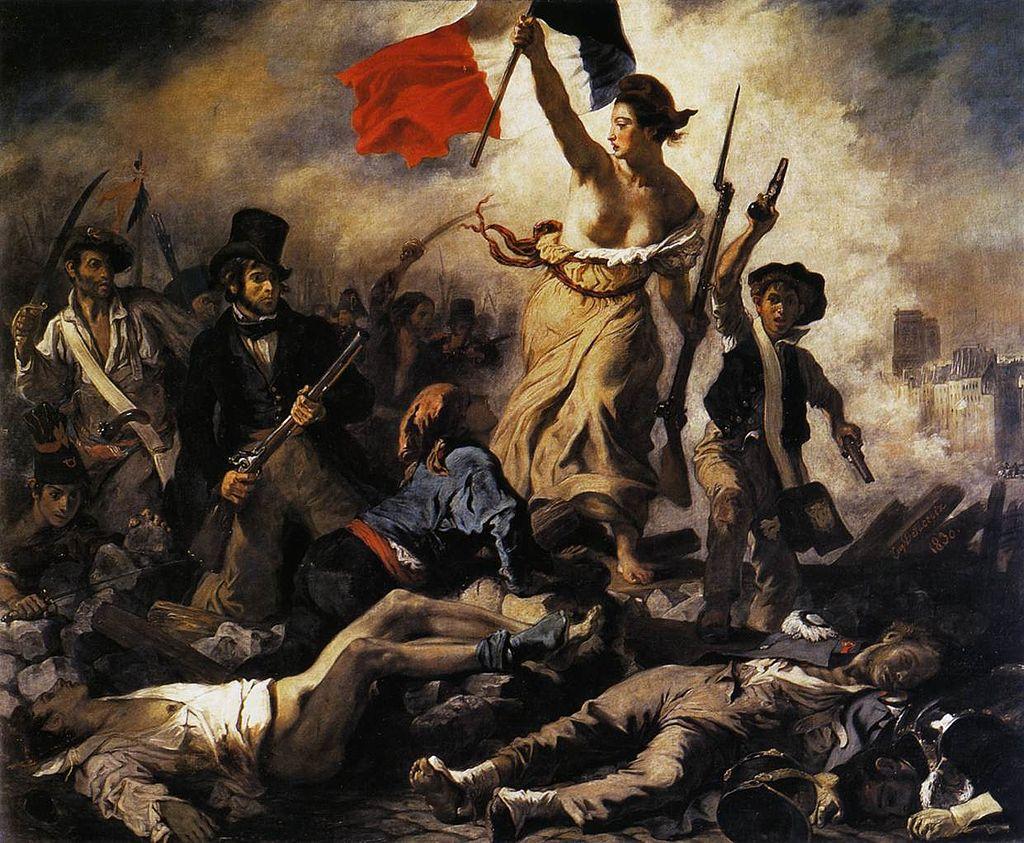Created by Maryn Torricelli on Thu, 02/10/2022 - 12:00
Description:
The painting Liberty Leading the People was painted by Eugene Delacroix in 1830. It portrays a characterization of Lady Liberty. She is standing in the center of the canvas on top of a mountain of rubble, and what appear to be bodies. She is hoisting the French flag into the air, gesturing to go forth in the battle. Her dress is torn exposing her bare breast. She is surrounded by men. Some carry weapons, others are wounded or dead. In the bottom left hand corner the eye is drawn towards a dead man laying on the ground. He is not wearing pants and is completely exposed.
Delacroix painted this in commemoration of the protests that took place in July of 1830. After Charles X enforced a barbaric set of ordinances, the working and middle-class citizens began to riot and protest for a span of three days.This later became known as les Trois Glorieuses. The upheaval was too much and eventually led to the abdication of Charles X from the throne. Delacroix was a prommant painter at the time and was often commissioned to complete pieces for royalty or for other elite members of society. Because of this financial reliance on his standing with this social class, he couldn't come out directly in support of the rebellion. Liberty Leading the People is a propaganda piece in support of the revolution, but Delacroix was precise in not making this obvious. He used different techniques, common during the Romantic period, to convey his outlook without making it blatantly obvious.
Delacroix’s use of color and lines help convey deep emotion. Predecessors of the Romantics valued clean strong lines. Before the Romantic painters the classical canon followed the Neoclassical and Enlightenment ideals. Subject matter was very important to them. They felt what they painted should affect their audience with reason and logic. The Romantics felt they should do the same but with emotions. In Liberty Leading the People Delacroix uses lighting to draw the eye to the man dead in the lower left corner. He is exposed so his skin is much lighter than the rest of the painting. His body is limp and blood stains his clothes. The scene draws a deep sadness from the audience. He uses feathery brushstrokes and undefined lines to create a dreamlike effect. Delacroix did not seek to paint a completely realistic view of the riots. He tried to convey the emotion behind those three days of gruesome events.
This painting was so important for its time for two reasons. The first was because it came to shape the key characteristics of what Romantic art would be. It focussed on the emotion rather than the realistic nature or moral content of previous era paintings. Second, it was a piece of propaganda. Later Delacroix would run into some resistance getting his paintings exhibited in salons. His “edgy” subject matter and divergence from the classical ideals was controversial and the Academy would not easily accept it. Liberty Leading the People is a great example of the appeal to emotions that the Romantics were obsessed with.
Work Cited:
Zygmont, Dr. Bryan, and Dr. Bryan Zygmont. “Eugène Delacroix, Liberty Leading the People.” Smarthistory, https://smarthistory.org/delacroix-liberty-leading-the-people/.
Tscherny, Nadia. “AN ENGLISH SOURCE FOR DELACROIX’S ‘LIBERTY LEADING THE PEOPLE.’” Source: Notes in the History of Art, vol. 2, no. 3, [Ars Brevis Foundation Inc., University of Chicago Press], 1983, pp. 9–13, http://www.jstor.org/stable/23202307.


